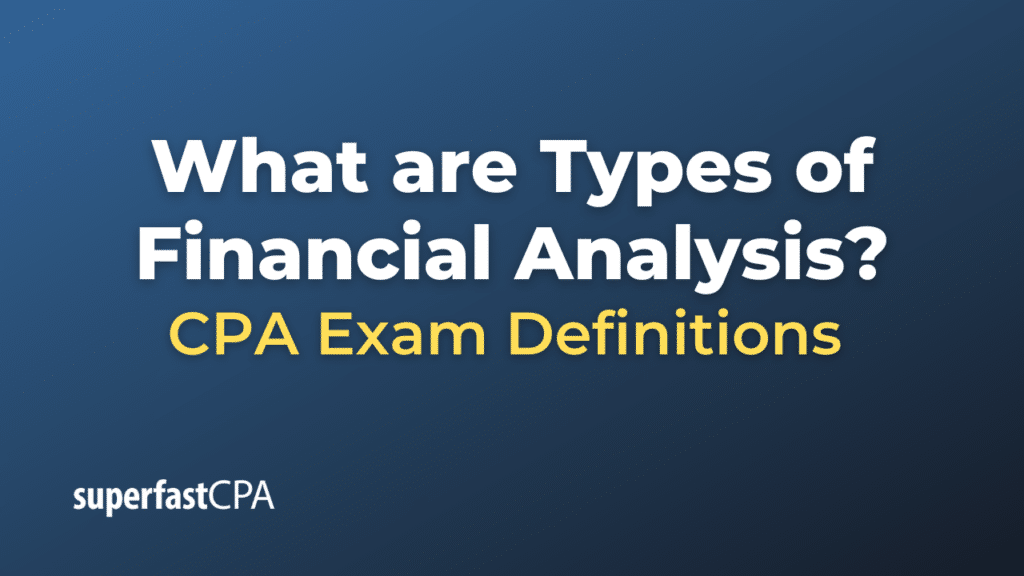Types of Financial Analysis
Financial analysis is a method of evaluating the financial performance and position of a company, project, or investment. Different types of financial analysis provide insights into various aspects of a business’s health or an investment’s potential. Here are some of the primary types of financial analysis:
- Horizontal Analysis (Trend Analysis):
- Compares financial data over multiple periods.
- For instance, observing how revenue has grown over the past five years.
- Vertical Analysis (Common Size Analysis):
- Evaluates each line item of a financial statement as a percentage of a base item (e.g., total assets or sales).
- Useful for comparing financial statements of companies of different sizes.
- Ratio Analysis:
- Compares different figures from the balance sheet, income statement, and cash flow statement to gain insights about a company’s performance and financial health.
- Common ratios include liquidity ratios, solvency ratios, profitability ratios, and efficiency ratios.
- Cash Flow Analysis:
- Evaluates a company’s cash inflows and outflows.
- Helps determine the company’s liquidity and ability to generate and use cash.
- Profitability Analysis:
- Examines a company’s revenue generation ability and its profitability trends.
- Key metrics include Gross Profit Margin, Operating Profit Margin, and Net Profit Margin.
- Liquidity Analysis:
- Assesses a company’s ability to meet its short-term obligations.
- Liquidity ratios like the Current Ratio and Quick Ratio are often used.
- Solvency Analysis:
- Evaluates a company’s ability to meet its long-term obligations.
- Key ratios include the Debt-to-Equity Ratio and Times Interest Earned.
- Break-even Analysis:
- Determines the point at which total revenue equals total costs, indicating no net profit or loss.
- Used to establish pricing strategies and understand fixed and variable costs.
- Variance Analysis:
- Compares actual performance to budgeted or forecasted performance to identify deviations.
- Helps in monitoring and controlling costs.
- Investment Appraisal (or Capital Budgeting):
- Evaluates the attractiveness of an investment opportunity using methods like Net Present Value (NPV), Internal Rate of Return (IRR), and Payback Period.
- DuPont Analysis:
- A detailed approach to return on equity (ROE) breakdown, linking profitability, efficiency, and leverage to assess the quality of the ROE.
- Scenario & Sensitivity Analysis:
- Evaluates how changes in key input variables impact the outcome.
- Scenario analysis examines various possible situations, while sensitivity analysis gauges the impact of changing one variable at a time.
- Valuation Analysis:
- Determines the value of a business, asset, or investment.
- Methods include the Discounted Cash Flow (DCF) method, comparable company analysis (CCA), and precedent transaction analysis.
The type of financial analysis to use depends on the objective of the analysis. Whether you’re evaluating an investment opportunity, monitoring your company’s financial health, or planning for the future, the appropriate method can offer invaluable insights.
Example of Types of Financial Analysis
Let’s illustrate some of these financial analysis types with a fictional company, “EcoFab Apparel.” EcoFab produces sustainable fashion and has been in business for several years.
1. Horizontal Analysis:
- In 2022, EcoFab’s revenue was $1 million. In 2023, it grew to $1.2 million.
- Revenue growth = (($1.2M – $1M) / $1M) × 100 = 20% increase
2. Vertical Analysis:
- From EcoFab’s 2023 income statement:
- Revenue: $1.2 million
- Cost of Goods Sold (COGS): $600,000
- COGS as a percentage of Revenue = ($600,000 / $1.2M) × 100 = 50%
3. Ratio Analysis:
- Current Ratio (from balance sheet data):
- Current Assets: $500,000
- Current Liabilities: $300,000
- Current Ratio = Current Assets / Current Liabilities = 1.67
4. Cash Flow Analysis:
- From the 2023 cash flow statement, EcoFab:
- Generated $400,000 from operating activities
- Used $200,000 in investing activities
- Raised $100,000 from financing activities
- Net increase in cash: $300,000
5. Profitability Analysis:
- Gross Profit Margin:
- Gross Profit = Revenue – COGS = $1.2M – $600,000 = $600,000
- Gross Profit Margin = (Gross Profit / Revenue) × 100 = 50%
6. Liquidity Analysis:
- Quick Ratio (Assuming inventory = $200,000):
- (Current Assets – Inventory) / Current Liabilities = ($500,000 – $200,000) / $300,000 = 1
7. Solvency Analysis:
- Debt-to-Equity Ratio (Assuming long-term debt = $500,000 and shareholders’ equity = $700,000):
- Debt-to-Equity = Long-term Debt / Shareholders’ Equity = $500,000 / $700,000 = 0.71
8. Break-even Analysis:
- If each EcoFab product is sold for $50 and the variable cost per product is $30, with fixed costs being $200,000:
- Break-even point in units = Fixed Costs / (Selling Price – Variable Costs) = $200,000 / ($50 – $30) = 10,000 units
- If EcoFab budgeted for $1.1 million in revenue for 2023 but achieved $1.2 million:
- Revenue Variance = Actual Revenue – Budgeted Revenue = $1.2M – $1.1M = $100,000 (favorable)
10. Investment Appraisal:
- Assuming EcoFab is evaluating a new $250,000 machinery purchase expected to generate $70,000 additional profit per year for 5 years:
- Payback Period = Initial Investment / Annual Cash Inflow = $250,000 / $70,000 = 3.57 years
These examples showcase how various financial analysis techniques can be applied to evaluate different aspects of a company’s performance and financial health. For any business, consistent analysis using these methods helps in informed decision-making.













